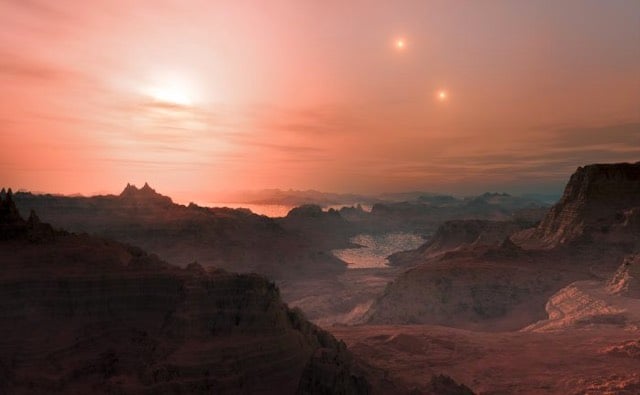Possible Earth-like planet discovered orbiting star nearest Earth

The scientific rumor mill is saying that astronomers in Chile have discovered an Earth-like exoplanet orbiting the star nearest Earth, Alpha Proxima, a mere 4.25 light years away. As they say, “huge if true”.
The hunt for exoplanets has been heating up in recent years. Since it began its mission in 2009, over four thousand exoplanet candidates have been discovered by the Kepler mission, several hundred of which have been confirmed to be “Earth-like” (i.e. terrestrial). And of these, some 216 planets have been shown to be both terrestrial and located within their parent star’s habitable zone (aka. “Goldilocks zone”).
But in what may prove to be the most exciting find to date, the German weekly Der Spiegel announced recently that astronomers have discovered an Earth-like planet orbiting Proxima Centauri, just 4.25 light-years away. Yes, in what is an apparent trifecta, this newly-discovered exoplanet is Earth-like, orbits within its sun’s habitable zone, and is within our reach. But is this too good to be true?
If you read the article, there’s cause for skepticism but an official announcement is coming next week so we’ll know for sure one way or the other.
The other cool thing? If there is a planet there, plans are already underway to build a project to get probes to nearby Alpha Centuri in 20 years, Project Starshot:
In the last decade and a half, rapid technological advances have opened up the possibility of light-powered space travel at a significant fraction of light speed. This involves a ground-based light beamer pushing ultra-light nanocrafts - miniature space probes attached to lightsails - to speeds of up to 100 million miles an hour. Such a system would allow a flyby mission to reach Alpha Centauri in just over 20 years from launch, and beam home images of possible planets, as well as other scientific data such as analysis of magnetic fields.
Perhaps they can redirect their target slightly?
Update: It appears as if the rumors were true. Phil Plait writing at Slate:
The planet, called Proxima Centauri b or just Proxima b (exoplanets are given their star’s name plus a lower case letter in order of discovery, starting with “b”), orbits Proxima every 11.2 days. It has a mass of no less than 1.3 times the Earth’s, so if it’s rock and metal like Earth it’s only a bit bigger. It’s a mere 7.3 million kilometers from the star-a lot closer than Earth’s distance from the Sun of 150 million kilometers!-but Proxima is so faint and cool it receives about two-thirds the amount of light and heat the Earth does. That means that it’s in Proxima’s habitable zone: It’s possible (more or less) that liquid water could exist on its surface.
That’s coooool.
Update: Project Blue wants to built a space telescope for the purpose of observing and photographing Earth-like planets around Alpha Centuri.
Project Blue is a consortium of leading space and research organizations on a mission to build and launch a small space telescope to observe planets around our nearest stellar neighbors: Alpha Centauri A and B. The goal is simple: to capture an image, visible to the human eye, of orbiting planets. Seeing a “pale blue dot” could indicate the presence of oceans or an atmosphere — the potential to support life. It would be our first view of another world like our own. With a modest budget and a planned launch by 2020, this goal is tantalizingly close.
Update: According to some recent observations, it seems likely that the Earth-like planet orbiting Proxima Centauri has been fried to a crisp many times by solar flares.
When they calculate the total energy of the big flare, it is ten times more powerful than one of the Sun’s bigger flares! That’s a lot of energy. So much, in fact, that the planet, Proxima b, would get good and fried by it. I mean crispy. The planet orbits the star much closer than Earth does the Sun, about 7 million kilometers from Proxima, so the energy from the flare would hit it a lot harder. Assuming these flares happen relatively often (a very safe bet), over the lifetime of the planet these would basically sandblast the planet, ripping the atmosphere right off the planet. They’d strip away any oceans, too, and sterilize whatever was left.
It’s hard to overstate the damage. These flares, over billions of years, are downright apocalyptic. It’s hard to imagine anything being able to survive. The planet may very well be a completely zapped airless lifeless ball of rock.





Stay Connected